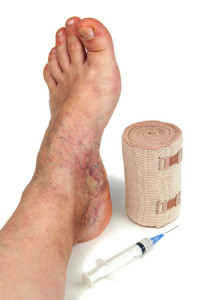
What are spider veins?
Normally blood travels through healthy veins up to the heart. Spider veins, however, are abnormally dilated veins that cannot perform their function.
Spider veins are the tiny red or blue vessels that can appear anywhere on the body but more commonly on the legs, face, chest or even abdomen. They may be visible as short, seemingly unconnected lines each about the size of a large hair or they may resemble a spider web or tree with branches. In medical terms spider veins are called “telangiectasias”. They usually occur in association with larger dilated blood vessels (often blue / green in colour) called “reticular veins”.
Often dilated blood vessels cause aching especially with prolonged standing. Although dilated blood vessels do carry blood they are not very efficient and are often not necessary to the circulatory system. The body will have already established an alternative route for the blood to travel back more efficiently to the heart (deep venous system). Thus they can be treated without damaging the circulation (treatment actually improves venous circulation). The chance for a greatly improved appearance is about 80 per cent depending on the severity of the problem. Treatment will also usually relieve any symptoms caused by the veins.
What causes spider veins?
Since our ancestors decided to stand upright, our leg veins have been faced with the difficult task of taking the blood right up to the heart against the pulling force of gravity. To do this the leg veins depend on the contraction of the calf and thigh muscles to pump the blood up. This is why walking is good for your circulation.
So when you walk, the contraction of your leg muscles pumps the blood up. However, as we know “what goes up must come down” which is what happens to blood in the leg veins.
Therefore to prevent the blood from falling right back down, the nature has designed valves in the leg veins which open in only one direction: upwards. So the valves allow the blood to get through but when it comes back down, the valves shut and stop the blood going all the way down. Next contraction would send the blood even higher till it finally reaches the heart.
In vein disease, the underlying problem appears to be damage to the valves. The abnormal reticular veins, for instance, act as “feeders” of the spider veins. The blood flow in these feeder veins can be resembled to a “two-way” street. In other words, blood in the feeder veins can go back and forth. This backward flow through the incompetent valves dilates up the smaller veins (medically called “post-capillary venules”). These dilated post-capillary venules are called “spider veins”.
During pregnancy the enlarged uterus may also restrict blood flow in the veins of the abdomen contributing to the development of varicose veins. Spider veins may also occur after trauma to a certain area of the body or as a result of wearing tight girdles. They also appear to be associated with obesity and occupations involving prolonged standing. When they occur on the face or chest, spider veins may be related to chronic sun exposure, alcohol or exposure to extremes of temperature.
Can vein problems be prevented?
There is no known method of prevention. Wearing specialized venous support stockings may prevent some dilated blood vessels from developing in some people. Maintaining a normal weight, regular exercise, avoiding constipation and avoiding wearing high heeled shoes may also be helpful.
